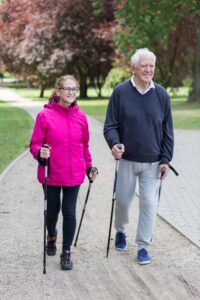Written by Taylor Woosley, Staff Writer. Results of the longitudinal study using data from TILDA shows that rates of depressive symptoms were 20% lower among subjects with high physical activity levels compared to participants with low physical activity levels.
 Depression is the leading cause of mental health-related disease burden and a major cause of disability worldwide, affecting approximately 280 million people1. It is often associated with a significant reduction in lifespan and is associated with a marked increase in vulnerability to major medical disorders, including cardiovascular disease, autoimmune disease, diabetes, and cancer2. Depression is frequent in the elderly population, with prevalence rates of depressive symptomatology to be 19.5% in individuals 50 years and older3.
Depression is the leading cause of mental health-related disease burden and a major cause of disability worldwide, affecting approximately 280 million people1. It is often associated with a significant reduction in lifespan and is associated with a marked increase in vulnerability to major medical disorders, including cardiovascular disease, autoimmune disease, diabetes, and cancer2. Depression is frequent in the elderly population, with prevalence rates of depressive symptomatology to be 19.5% in individuals 50 years and older3.
Depressed patients are often treated with antidepressants or psychological therapy that can be ineffective or cause side effects4. Research has shown that physical activities can reduce or prevent geriatric depression5. Physical activity can bring about changes in endorphin and monoamine levels and decrease cortisol levels, which may result in an improvement in subjects’ mood6.
Laird et al. conducted a longitudinal investigative study to quantify the lowest amount of moderate to vigorous physical activity (MVPA) associated with a lower risk of depressive symptoms and major depression status among older adults using data from waves 1 to 5 of The Irish Longitudinal Study on Ageing (TILDA). TILDA is a population representative study of adults aged ≥50 years residing in the Republic of Ireland. Data used covered 10 years of TILDA research, with each wave containing the same participants with detailed information on demographic, health, lifestyle, and social factors reported through self-completed questionnaires, nurse health assessments, and interviews.
Depressive symptoms were assessed using the short form of the Centre of Epidemiological Studies Depression (CES-D) which was completed during each TILDA wave. Waves 2-5 also included the Composite International Diagnostic Interview to quantify the occurrence of a major depressive episode within the last year. Self-reported physical activity levels were measured using the short-form International Physical Activity Questionnaire during each wave.
Covariates included chronic disease burden, age, sex, education levels, antidepressant use, lifestyle factors, and body mass index (BMI). 4491 participants, 2205 women (54.9%) and 1811 men (45.1%) with a mean [SD] age of 61.0 [8.1] years, were included in the final analysis. Significant findings of the study are as follows:
- During 10 years of follow-up, depression increased from 8.2% (95%CI, 7.4%-9.1%) to 12.2% (95% CI, 11.2%-13.2%). Furthermore, subjects meeting or exceeding physical activity guidelines (>600 MET-min/wk) decreased from 51.1% (95% CI, 49.5%-52.6%) at wave 1 to 40.9% (95% CI, 39.3%-42.4%) at wave 5.
- Rates of depressive symptoms were 20% lower among participants with high physical activity compared with low physical activity individuals (AIRR, 0.80; 95% CI, 0.78-0.84).
- Bonferroni-corrected post hoc analysis showed that participants performing 400 to less than 600 MET-min/wk had a 16% lower rate of depressive symptoms compared with 0 MET-min/wk (AIRR, 0.84; 95% CI, 0.81-0.86).
- Compared with low-dose physical activity, moderate physical activity was associated with 42% lower odds of major depression (AOR, 0.58; 95% CI, 0.43-0.76) for chronic disease subjects and, for non-chronic disease participants, high-dose physical activity was associated with 35% lower odds of major depression (AOR; 95% CI, 0.45-0.95).
Results of the study show that MVPA positively benefits subjects mental health and is associated with a reduced risk of depressive symptoms and major depression. Furthermore, a dose-response association was found between MVPA and depression. Study limitations include the self-reporting nature of information on physical activity levels and depressive symptoms which could potentially lead to over or under reporting data.
Source: Laird, Eamon, Charlotte Lund Rasmussen, Rose Anne Kenny, and Matthew P. Herring. “Physical activity dose and depression in a cohort of older adults in the Irish longitudinal study on ageing.” JAMA Network Open 6, no. 7 (2023): e2322489-e2322489.
JAMA Network Open. 2023;6(7):e2322489. doi:10.1001/jamanetworkopen.2023.22489
Click here to read the full text study.
Posted August 29, 2023.
Taylor Woosley studied biology at Purdue University before becoming a 2016 graduate of Columbia College Chicago with a major in Writing. She currently resides in Glen Ellyn, IL.
References:
- Pearce M, Garcia L, Abbas A, et al. Association Between Physical Activity and Risk of Depression: A Systematic Review and Meta-analysis. JAMA Psychiatry. Jun 1 2022;79(6):550-559. doi:10.1001/jamapsychiatry.2022.0609
- Beurel E, Toups M, Nemeroff CB. The Bidirectional Relationship of Depression and Inflammation: Double Trouble. Neuron. Jul 22 2020;107(2):234-256. doi:10.1016/j.neuron.2020.06.002
- Maier A, Riedel-Heller SG, Pabst A, Luppa M. Risk factors and protective factors of depression in older people 65+. A systematic review. PLoS One. 2021;16(5):e0251326. doi:10.1371/journal.pone.0251326
- Chen C, Beaunoyer E, Guitton MJ, Wang J. Physical Activity as a Clinical Tool against Depression: Opportunities and Challenges. J Integr Neurosci. Jul 22 2022;21(5):132. doi:10.31083/j.jin2105132
- Byeon H. Relationship between Physical Activity Level and Depression of Elderly People Living Alone. Int J Environ Res Public Health. Oct 22 2019;16(20)doi:10.3390/ijerph16204051
- López-Torres Hidalgo J. Effectiveness of physical exercise in the treatment of depression in older adults as an alternative to antidepressant drugs in primary care. BMC Psychiatry. Jan 14 2019;19(1):21. doi:10.1186/s12888-018-1982-6
